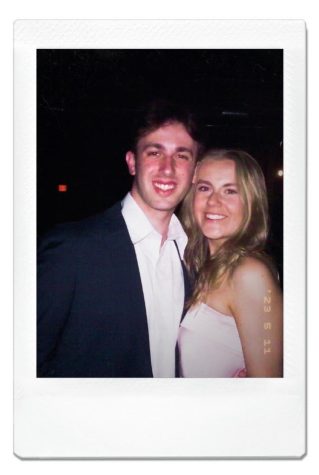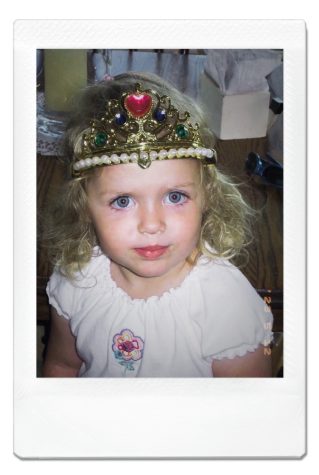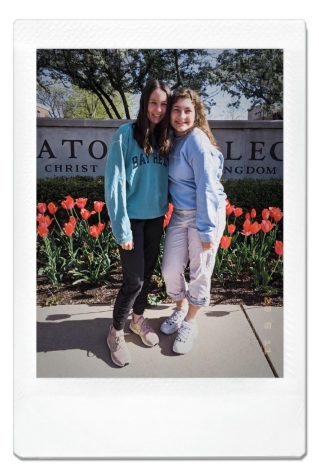Academite details unorthodox high school experience

FOUR YEARS OF SMILES: Smiling for pictures on May Day, senior academites (from left to right), Brigid Murphy, George Wood, Elizabeth Shaw and Bonnie Puppala have endured the rigors of Academy. The Glenbrook Academy of International Studies is a four-year GBS & GBN collaborative program promoting an interdiciplinary education in social studies, English and world language.
May 25, 2018
The Glenbrook Academy of International Studies. Academy. Acad.
Casting all formal titles and nicknames aside, this elusive and exclusive group of teenagers yielded an academic experience so unconventional, yet powerful, that I could never imagine my last four years any other way.
Academy exists as a nebulous and confusing entity rife with stereotypes. We even have an Urban Dictionary entry, which has perpetuated these assumptions since its posting in 2010: “A collection of at any given time 120 or so high schoolers lacking enough social skills to adequately communicate and so smart they could probably end world hunger if they weren’t so busy discussing it. Known to have affinities for debate, music, technology, etc. Often abbreviated simply to ‘the Academy.’”
While this may strike some outsiders as shocking, this definition does not accurately depict a typical Academy student or encompass the values of the program as a whole. While we are often stereotyped as a group of antisocial geniuses, it’s truly just a group of highly motivated, intelligent teens who seek a deeper connection between their studies and peers. I promise, we are just like you and all your average high schoolers!
First, let’s set the record straight: this group consists of fifteen students from GBS and fifteen students from GBN that embarks upon a four-year, interdisciplinary education in social studies, English and world language to cultivate a comprehensive global lens on both local and international issues.
What this means is the thirty of us take our humanities-based classes in tandem with each other and the curriculums play off of what we are learning in each subject. For example, when we were studying the Roaring Twenties in U.S. History, we read and discussed F. Scott Fitzgerald’s The Great Gatsby to supplement our learning in both social studies and English. This encompasses the whole interdisciplinary learning idea, where different avenues of knowledge intersect to form a greater understanding of a topic.
It all begins in eighth grade with a personal essay, a list of all your activities and awards and three teacher recommendations. All applicants are then invited to the interview stage comprised of a test and a formal interview. If you are successful, this all culminates in one short phone call from THE Mr. Matthew Whipple, the director of the Academy, congratulating you on your acceptance.
I was ecstatic about my high school achievements I had gained before even leaving Springman Middle School. But, the issue with this induction method left me wondering: did I truly know what I was getting myself into or even what I would want out of high school years down the road?
I consider my acceptance into the Academy as an honor, but an honor was often accompanied by a feeling of being stuck: stuck with the same peers for four years; stuck with a predetermined schedule; stuck with a decision I made in eighth grade.
While the schedule and structure of Academy prevented me from taking classes that intrigued me, calling it quits would have kept me from some of my greatest high school experiences. Academy takes up the time of four blocks, but with three classes. So with early bird gym, which was a no brainer for me, I could only take seven classes; this made certain classes impossible to fit into my schedule.
Take Chinese, for example: Over my four years, I struggled at times to appreciate this language, but how many 18-year-olds get to say they have road tripped through China without their parents but with a few of their favorite teachers for two weeks?
The Academy has also introduced me to teachers who possess unmatched passion for their subjects. Their courses also taught me the meaning of accomplishment when faced with true academic rigor. My junior year United States History teacher, Mr. Meyer, emphasized this to inspire students to achieve the highest expectations.
If I ever fantasized about dropping out, or dare I say the end of Academy, I knew I could never follow through because I would miss my peers and the Academy bubble I grew so accustomed to during my four years. While this has been the epitome of an unconventional high school experience, it’s been mine. Despite feeling stuck in a premature decision, I embraced this community to the best of my ability.
Good luck, current and future Academites. And I hope I cleared some things up for everyone else.












